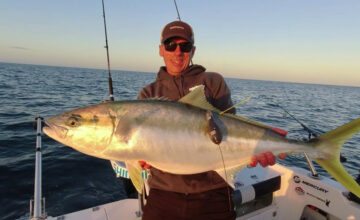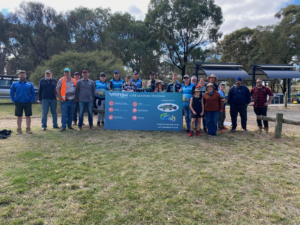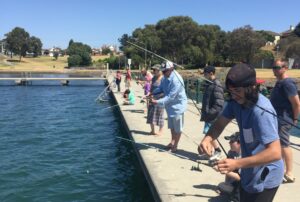May 7, 2020
By Dr. Corey Green
Senior Fisheries Scientist, Victorian Fisheries Authority
Prior to the early 1990’s, yellowtail kingfish (Seriola lalandi) were commonly caught by recreational anglers at various offshore locations across Victoria, primarily in the warmer months. While the historic abundance of yellowtail kingfish in Victorian waters was not as high as in New South Wales waters, the fish were often very large (up to 30+ kg), particularly around the entrance to Port Phillip Bay (‘The Rip’). During the mid-1990’s both the number and size of yellowtail kingfish taken by recreational anglers in Victorian waters decreased dramatically. Consequently, interest in targeting yellowtail kingfish declined. The low availability of yellowtail kingfish to Victorian anglers continued until about 2010 when exceptional catches during summer and autumn were reported. It is clear from the resurgence of targeted recreational fishing that their availability has increased considerably over the last decade.
The reasons for the recent increased availability are unclear, and it is a shared goal for managers and anglers alike, that the current great fishing for yellowtail kingfish in Victorian waters is sustained for the long-term. Uncertainties included a limited knowledge of:
- yellowtail kingfish stock structure around southern and eastern Australia,
- migratory dynamics and residency behaviour in Victorian waters,
- length and age composition, and basic biological characteristics (growth, reproduction) of yellowtail kingfish occurring in Victorian waters.
Funded by recreational fishing licences, this project aimed to apply multiple approaches to improve understanding of the yellowtail kingfish fishery in Victoria including; genetics, biological sampling, otolith chemistry and a trial of satellite tags. Additional components of the study included a review of historical records of recreationally caught yellowtail kingfish and the potential for marine stocking of the species in Victorian waters.
Results from the genetic component of this study confirmed a separate genetic stock of yellowtail kingfish in WA and supported a single stock hypothesis across eastern and south-eastern Australian waters with minor regional genetic variation detected using the most powerful genetic methods.
Growth rates and length/age at maturity for yellowtail kingfish in Victoria were generally consistent with studies from NSW. Length/age compositions of recreationally caught fish in Victoria varied between the eastern, central and western regions of the State, with greater proportions of larger/older fish present in eastern and western Victorian waters. However, across all three regions most fish were less than 100 cm total length, less than 6 years of age, and immature. No evidence of spawning fish was found, although females with developed gonads were observed. The dominance of smaller fish in the contemporary fishery is not consistent with the historical records and anecdotally fish greater than 100 cm and 10+ kg were very common prior to the early 1990’s. The current fishery is likely to be in a recovery phase driven by improved management, reduced harvest and higher recruitment over the last decade, and it’s therefore likely that high fishing mortality (particularly of juvenile yellowtail kingfish in NSW), and sustained poor recruitment likely influenced the decline of yellowtail kingfish in Victoria in the early 1990’s rather than an abrupt change in their migratory patterns or habitat preference.
One yellowtail kingfish in this study was successfully tagged with a satellite tag. A 65cm kingfish carrying a satellite tag was released off Lady Julia Percy Island, near Port Fairy, on 5 April 2017 and swam south to the continental slope before reaching King Island on 19 May. It then headed east to the islands off Wilsons Promontory in late May, after which time the tag automatically released in June off Flinders Island. During its 69-day marathon swim, this kingfish travelled 1000km or about 14.5km per day on average. It reached a maximum depth of 70m, experienced temperatures between 14.5 and 17 degrees and when in Bass Strait, only swam in surface waters of 12m or less.
A trial of otolith (ear bones) stable isotopes in this study, in particular the oxygen isotope ratio (18O/16O) supported the application of this technique to expanded studies of thermal history and population structure. The results supported the hypothesis that Victorian yellowtail kingfish start their lives in warmer waters outside of Victoria, most likely along the eastern seaboard off NSW, but spend more time in cooler waters as they get older. This is consistent with a model of seasonal migration between NSW and Victoria and habitat suitability.
Finally, a review of stocking potential indicated that hatchery production of yellowtail kingfish is well established in Australia. However, due to the temperature preferences of the species, and their known summer–autumn occurrence in Victorian waters it is likely they would migrate out of Victorian waters before they reach the legal minimum length. As such, benefits to Victorian anglers would be expected to be limited, and heavily dependent on uncertain return migrations of stocked fish.
Given the interest of this species, the Fisheries Research and Development Corporation have recently funded a cross jurisdictional workshop to review the current status of the SE Australian population yellowtail kingfish population.

The full report can be downloaded at http://www.vfa.vic.gov.au/kingfishreport
Related information:
Interested in game fishing in Victoria? Make contact with the Gamefishing Association of Victoria to find your local club.
Do you target kingfish in Port Phillip Rip? Make sure you connect with our Steer Clear in the Rip campaign.








